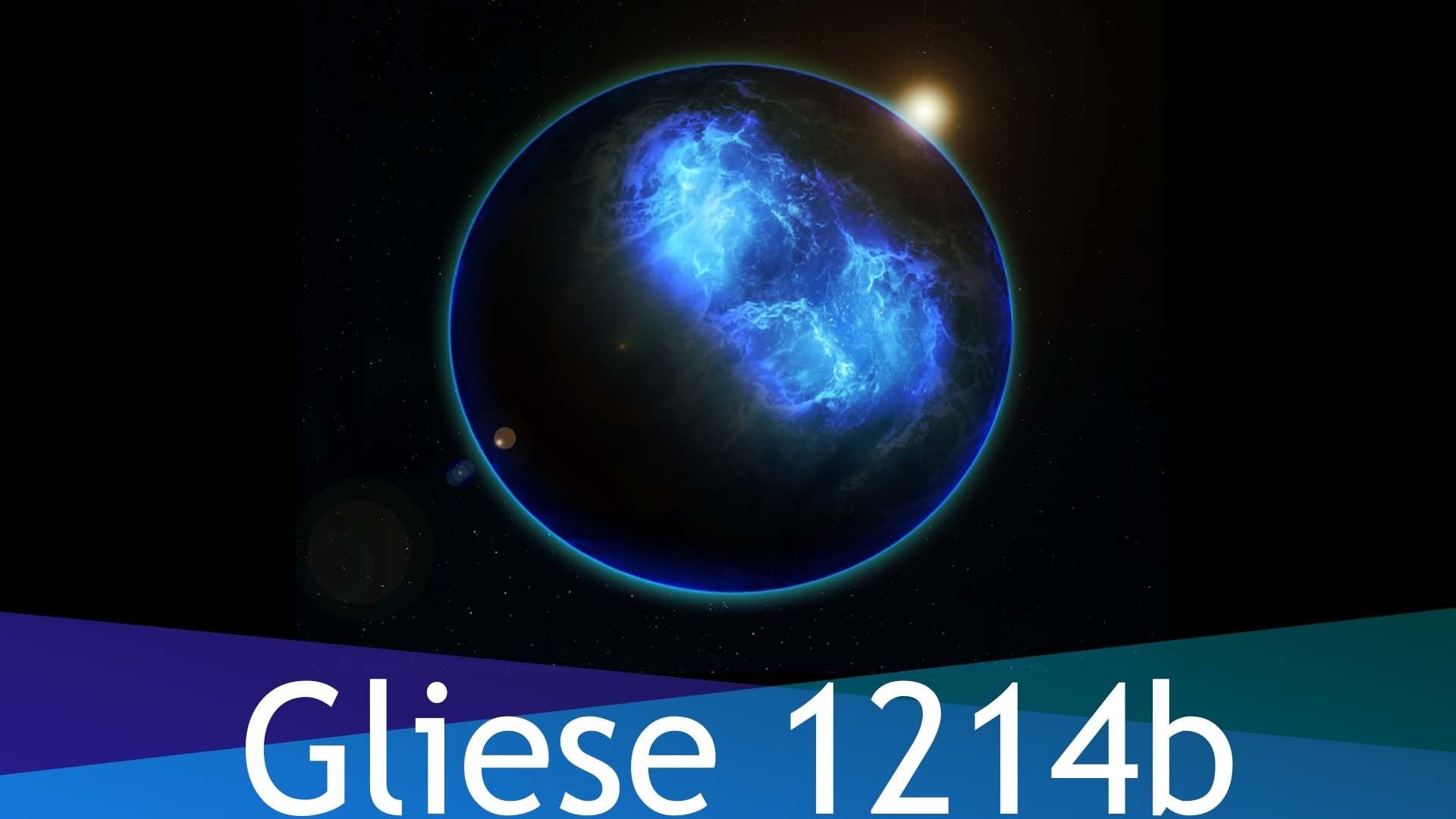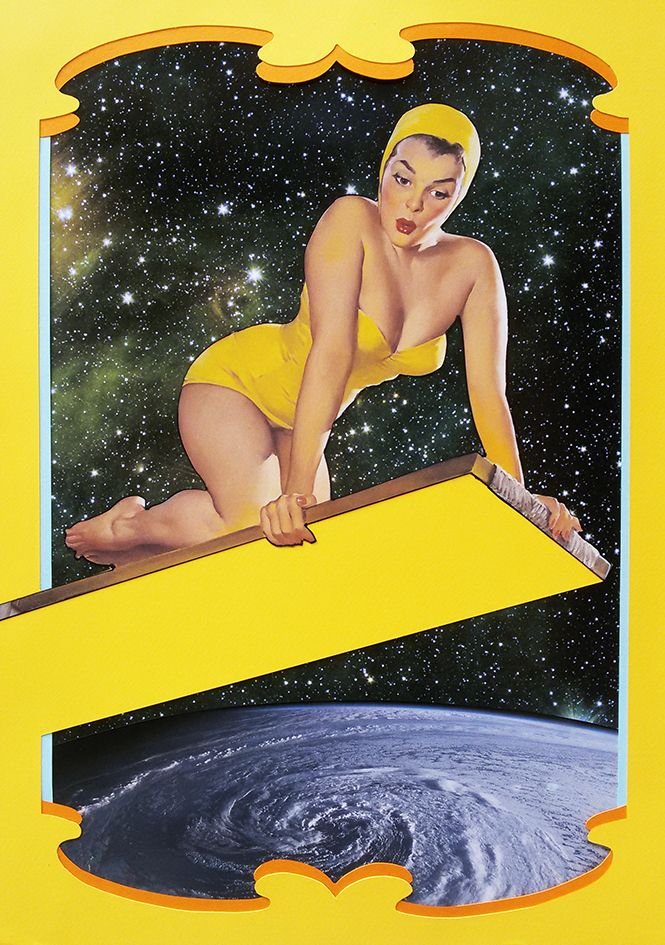
With an army of ground-based telescopes and the now-famous Keplar in orbit, the number of satellites seeking exoplanets is phenomenal and to date, there are well over 1,000 exoplanets officially discovered and countless more to be announced. In fact, scientists are starting to wonder if there are any stars *without* planets orbiting them. Everywhere they look, at least one exoplanet can be found even with our primitive techniques of spectroscopy and gravitational lensing.
This series is going to dig into that database of exoplanets and pick some of the most exciting and crazy discoveries to share, from planets that rain diamonds, to planets that are one giant diamond... From planets ripe for potential life to ones that are 4,000 degrees C and, well, not so ripe for life.
Today, I present to you, Gliese 1214b featuring the fantastic artist @georgeboyaWater World.

Gliese 1214b is a super Earth 42 lightyears from here. It is 7 times the mass and about 2.7 times the diameter. The main difference apart from size is the sheer amount of water. Where Earth’s mass is composed of 0.02% water, Gliese may be over 10% comprised of water. This means it could very well be entirely oceanic, with waters reaching hundreds of miles in depth.
This is not actually as surprising as you might think; water is one of the most abundant molecules in the Universe thanks to the fact that both Hydrogen and Oxygen are two of the most abundant elements, so it stands to reason that a whole bunch of it would mass together under the pull of gravity.
Can it harbor life?
Water is typically what Astrophysicists and Astrobiologists look for when searching for life for the above reason. It’s no coincidence that all life on earth is Carbon based, breathe oxygen and depends on water to survive. Including the aforementioned ubiquitous Hydrogen and Oxygen, the most abundant elements on earth in order of abundance are:
A) Hydrogen
B) Helium (inert)
C) Oxygen
D) Carbon
So a water world should be a hopeful place to look for life. But to understand the potential of Gliese 1214b, we need to look at the four categories of possible water worlds:
- Epipelagic
- Bathypelagic
- Abyssopelagic
- Stereopelagic
On earth, these translate to oceanic zones ranging from 0m to 8,000m+ in depth, but in space, these depths can potentially reach *hundreds of miles* down.
Epipelagic
These worlds are not too common, but not super rare either. They have water across the surface no deeper than what a human could scuba dive. This type of planet would be a hotbed of life, perhaps more so than Earth. Its shallow depths mean sunlight can penetrate throughout water, allowing for photosynthesis, and a rocky seabed would allow tectonic activity to shift nutrients around and be a surface for all life to reside. Looking at earth, most sea life is in shallow water, with the deep oceans being largely devoid of life, so this makes sense
Bathypelagic
This is an Earth-type world, where water goes pretty deep, but may be scattered with many islands thrust up from geological activity, which could harbor life.
Abyssopelagic
Here is where life gets particularly difficult, and where Gliese 1214b is possibly classified. With water so deep, the tectonic activity would evidently be lacking, and even if that wasn’t the case, it just wouldn’t have the energy to push nutrients to the sunlit-depths where life could have its best chances to grow. That’s not to say it’s impossible for life, there could be small colonies of organisms near volcanic vents as we find on Earth, but there would simply not be enough resources for *intelligent* technological life to thrive.
That being said, this makes it a perfect location for humans to terraform. Floating islands are one way humans could feasibly colonize a new planet. This may seem radical, but it’s a much easier process than, say, interstellar colonization across a galaxy, or Dyson Spheres, where you mine the entire resources of the planets to completely enclose the sun with solar panels.
Materials could be collected from the ocean depths, so an underwater diamond dome could also be a potential living space. Diamond is quite easy to synthesize even with today’s technology and could easily withstand the pressures of deep waters.
The more water a planet has, the more massive it tends to be. With a larger mass, the increased gravity would attract more comets and space dust that may carry organic materials to trigger, or failing that support life.
This would also be a plentiful source of metals and other resources. Earth typically gets less impacts and space dust than average because massive Jupiter tends to suck all the danger into itself, but with a super Earth like 1214b, it may get the majority share of those important metals.
Stereopelagic
These are the toughest water world’s for life, and if 1214b falls under this category, we’d probably be out of luck when terraforming, too.
Stereopelagic planets have water so deep that the extremely high pressure at the bottom creates an exotic form of ice, ICE 7. Ice typically floats, but over 600MPAs (mega-pascals) of pressure, Ice 6 and above can form at room or even boiling temperature. Ice 7 is 70% denser than water, so it would remain sunken at the bottom of the ocean. This presents a problem for life.
With a thick layer of ice at the bottom of the water, the transportation of nutrients would be impossible, since the rocky surface (if there even is one) would be completely isolated. This would also make it impossible to mine for terraformation, and the importing of materials would be necessary, making the entire idea somewhat pointless.

So there you have it. Though life is not impossible for Gliese 1214b, it’s unlikely. But if there’s anywhere outside the solar system we might one day want to make into a giant holiday resort, this could be the place.

If you enjoyed this please check out @georgeboya who is a fantastic artist who creates insanely imaginative works with his bare hands, telling stories as he goes.
You can also check out the other things I do on Steemit:
Crazy evolution and nature
Fictional short stories
Ongoing post-apocalyptic story
Music - Kind of??
Blogs
